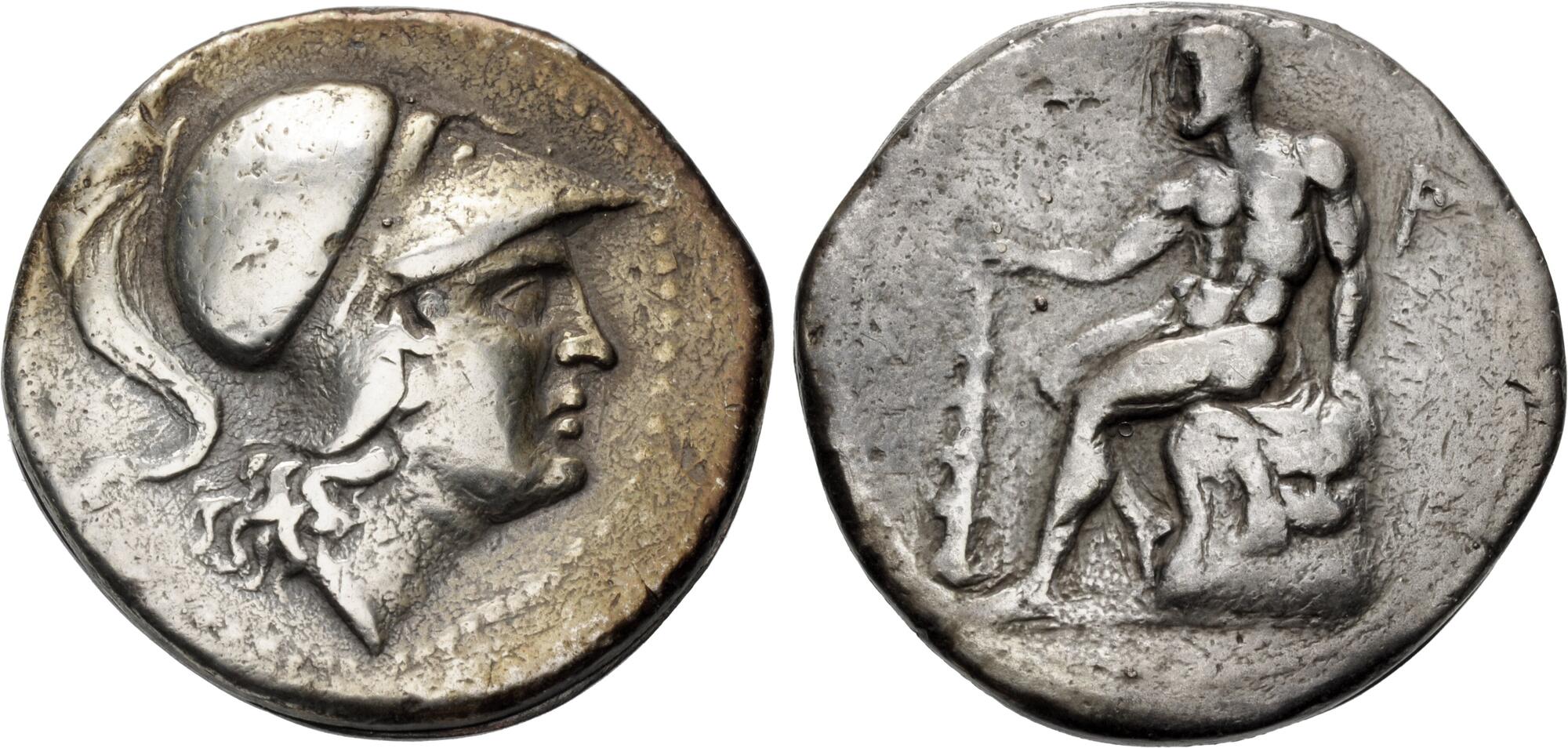H 181 - Lacedaemon (Nabis), silver, tetradrachms (206-197 BCE)
From SILVER
206 BCE - 197 BCE Silver 4,967 kg
Description
| ObverseInscription or printing placed on the obverse.: | Head of Athena right, wearing crested Corinthian helmet. |
| ReverseInscription or printing placed on the reverse.: | ΛΑ (Greek).Herakles seated left on lion skin draped over rock, holding club set on ground, [Λ] A across field. |
Mint and issuing power
| MintIdentifies the place of manufacture or issue of a numismatic object.: | Lacedaemon | Ancient regionAncient region.: | Peloponnesus (Laconia) | Modern countryModern country: Greece | AuthorityIdentifies the issuing power. The authority can be "pretended" when the name or the portrait of X is on the coin but he/she was not the issuing power. It can also be "uncertain" when there is no mention of X on the coin but he/she was the issuing power according to the historical sources: | Nabis of Sparta (king of Sparta, 192-177 BC) |
Chronology
| FromIdentifies the initial date in a range assigned in a numismatic context. | 206 BCE | toIdentifies the final date in a range assigned in a numismatic context.. | 197 BCE | PeriodTime period of the numismatic object.: Hellenistic 323-30 BC |
Physical description
| MetalThe physical material (usually metal) from which an object is made.: | Silver |
Median weightMedian of the weights of numismatic objects (in grams). in grams | 15.90 | DenominationTerm indicating the value of a numismatic object. Examples: tetradrachm, chalkous, denarius.: | tetradrachm |
StandardStandard.: |
Image

H181 Athena Herakles.jpeg [1]
References
| Die study referencePublication of the study: | Grunauer-von Hoerschelmann 19781Grunauer-von Hoerschelmann 1978 | ||
| Coin series referenceReference to coin series study: | RQEMH2RQEMH, n° 181 | ||
Obverse dies distribution
Reverse dies distribution
no distribution is available
Quantification
| Number of obversesNumber of obverse dies. ᵖ (o) | 10 | Number of singletons (o1)The number of singleton coins. ᵖ | 5 |
| Number of reverse diesNumber of reverse dies. (r) | 15 | Number of coinsNumber of coins. (n) | 21 |
| Coins per obverse dieNumber of coins per obverse die. (n/o) | 2.1 | Coins per reverse dieNumber of coins per reverse die. (n/r) | 1.4 |
| Reverse per obverse ratioRatio of obverse dies divided by reverse dies. (r/o) | 1.5 | Percentage of singletons (o1)number of coins (n) divided by the number of singletons (o1) ᵖ | 50 % |
| Original number of dies (O) (Carter 1983 formula)The estimation of the number of coins according to Carter 1983 ᵖ | 15.62 | Coins struck if 20,000 as average productivity per dieCoins made if the average productivity for obverses (according to Carter) is 20,000. ᵖ | 312,400 |
| Original number of dies (O) (Esty 2011 formula)The estimation of the number of coins according to the singleton formula in Esty 2011 ᵖ (O) | 19.09 | Survival rate if 20,000 as average productivity per dieSurvival rate if average productivity is 20,000. ᵖ | 0.00007 |
| Coverage (o = % of O) (Esty 1984 formula)Esty 1984 - coverage (% of O) ᵖ (o = % of O) | 76.19% | Die productivity if survival rate 1/2,000Average productivity if survival rate is 1/2,000. ᵖ | 2,688.86 |
| Weight of silver (in kg) if 20,000 coins per die (O = Carter formula)Carter 1983 * Median weight * 20000 (*10 if gold or electrum) ᵖ | 4,967 kg <br /> 4,967 kg | Die productivity if survival rate 1/5,000Average productivity if survival rate is 1/5,000. ᵖ | 6,722.15 |
Remarks
Most likely one single workstation